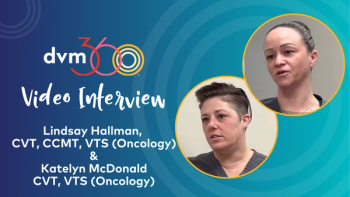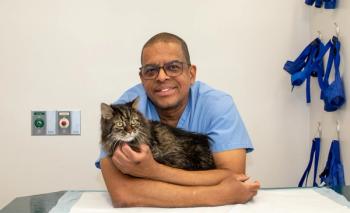
Tech Time: Samantha Newton, RVT, shares ER experiences, tourniquet tips, and professional growth mindset
Explore the journey of veterinary technicians as Samantha Newton, RVT, pursues specialty certifications, shares insights on emergency care, and discusses essential skills.
Happy National Veterinary Technician Week! To celebrate and honor all the hardworking veterinary technicians out there, this new episode of Vet Watch, hosted by Christopher Lee, DVM, MPH, DACVPM, is focusing on technicians for Tech Time. Join Lee and Samantha Newton, RVT, as they talk about her next career move, how far veterinary medicine has come, better technician utilization, and more.
Partial transcript
Christopher Lee, DVM, MPH, DACVPM: Because you [work the] overnight shift almost exclusively, what makes you love overnight more than day?
Samantha Newton, RVT: It is exclusive. I am not a day walker. When the sun comes up, I am ready to go to sleep.
Lee: Right back into your coffin.
Newton: Yep, right back. Just right back into my coffin.
Lee: Just pull the lid.
Newton: I like the pace of overnight. It's the time [when] no other vets are open. [Patients] can't get into their primary, [or] they've waited to get into their primary. It's [when] a lot of your more intense emergencies happen—[patients are] attacked by dogs, [bitten] by coyotes, [or] hit by cars. For some reason, huskies love to [have a] seizure at 3 [AM]. They just wait until about 3 [or] 4 [AM] to have cluster seizures. I don't know what it is, but that's usually when we see a lot of our patients coming in with seizures, particularly huskies. I don't understand what the correlation is there, but it happens.
Lee: Now, on the human side, it is interesting. My dad was a neurosurgeon, and they had done a study that when people, even though...an individual seizure patient...may [have seizures] at what appears to be random times of the day, if you take all the specific times, it actually only ended up in about 20 minutes for that individual.
Newton: Oh, wow.
Lee: Now the problem was that [it] could be at 3:16 AM, but when you added it up.... I've never read or seen anything like that for the veterinary side, but it would be, potentially, a scenario where dogs and breeds...[have] windows of time that are very specific for them to seizure.
Newton: That's really cool. I think...[for a] veterinary neurospecialist—if that's not already out there—that would be a really interesting scenario to look at, because it's the weirdest thing. It's like you have no seizure patients, and [then] it's 2 [or] 4 [AM], and...we have a patient seizure, and we have another patient seizure, and we're just like, "What happened?" Is it something in the water? [Is it] something in the moon cycle? Are we just having seizures today? What on earth is going on?
But I do like the [intensity]. Those days where it's just emergency after emergency—and true emergencies, not the [cases where they have] waited 3 weeks and [their] dog has had an ear infection, and now it has head tilts and eye twitching. Or [the client will ask], "Why is my dog walking in circles?" And then you...get a history, and they're like, "Oh, by the way, they've had an ear infection for 3 weeks." And [you think], "Cool. Well, now I know what the head tilt is from."
But...I like the pace of overnight. I feel—and this is just my opinion—that [during the] overnight [shift], we practice a lot of stabilization medicine where I just try to keep my patient alive and...get them as stable as possible. And I love [the] day shift...as my counterpart—the yin to our yang. We stabilize. We practice...the down and dirty, if you will.... We keep them alive. We get them set up for [the] day shift. Then our beautiful day shift nurses come in...bright-eyed, bushy-tailed, cheery...and they get to practice this healing medicine now. I've kept them alive, I'm passing the torch—fix them. Or at least get them to a point where they can get to specialty....
I'm not patient. I try to have patience with my patients.... I love [the] day shift because they nurture and have that healing medicine, [whereas] we're just like, "Fix it. Get them stabilized." We love them, but I have 3 other patients now doing some weird things over here that need to get fixed.
Newsletter
From exam room tips to practice management insights, get trusted veterinary news delivered straight to your inbox—subscribe to dvm360.






